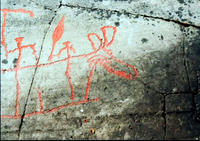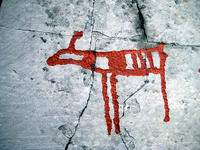You are in: Europe -> Norway -> Rock Art of Alta, and traditional search or Image Gallery will yield results of this site only
Rock Art of Alta
| Site number: | 352 |
|
| Type of site: | Cultural | |
| Date: | c. 4200-500 BC | |
| Date of Inscription: | 1985 | |
| Location: | Europe, Norway, county of Finnmark, Alta municipality | |
Up to 75 images are shown here. Click on each for more details or on Image Gallery for more images.
Six official UN languages:
Arabic,
Chinese,
English,
French,
Russian,
Spanish
Other languages: Danish, Dutch, German, Hungarian, Japanese, Norwegian-bokmål, Norwegian-nynorsk
Other languages: Danish, Dutch, German, Hungarian, Japanese, Norwegian-bokmål, Norwegian-nynorsk
| Description: | The Alta Fjord petroglyph group, close to the Arctic Circle, wears the traces of a c. 4200 - 500 B.C. settlement. The thousands of paintings and engravings augment our understanding of the prehistoric environment and human activities within these outer reaches of the Far North in those times. --WHMNet paraphrase from the description at WHC Site, where additional information is available. | |
| Rock carvings at Alta are part of an archaeological site near the town of Alta in the county of Finnmark in northern Norway. Since the first carvings — or more correctly, the petroglyphs — were discovered in 1972, more than 5000 carvings have been found on several sites around Alta. The main site, located at Jiepmaluokta about 4 kilometers outside of Alta, contains around 3000 individual carvings and has been turned into an open-air museum. The site was placed on the UNESCO list of World Heritage Sites on 3 December 1985. It is Norway's only prehistoric World Heritage Site. The earliest carvings in the area date to around 4200 BC; the most recent carvings are generally dated to around 500 BC, although some researchers believe carving continued until around 500 AD. The wide variety of imagery shows a culture of hunter-gatherers that was able to control herds of reindeer, was adept at boat building and fishing and practiced shamanistic rituals involving bear worship and other venerated animals. Apart from the visual evidence of the carvings themselves, not much is known about the culture that produced these carvings, although it has been speculated that the carvers might have been descendants of the Komsa culture. Some researchers also hold the belief that the Sami people are descendants of the carvers. At the time the carvings were created, northern Norway was inhabited by a culture of hunter-gatherers that are thought to be descendants of the Komsa culture, a stone age culture that expanded along the Norwegian coast following receding glaciation during the late ice age around 8000 BC. The period of almost 5000 years over which carvings were created at the site saw many cultural changes, including the adoption of metal tools and advances in areas such as boat building and fishing techniques; therefore, the carvings show a wide variety of mundane imagery and religious symbolism. Rock carvings especially from the earliest period show great similarity with carvings from northwestern Russia, indicating contact between and maybe parallel development of cultures over a wide area of Europe's extreme North. A wide array of animals are depicted on carved scenes; among them, reindeer are clearly predominant and are often shown in large herds that are alternatively nurtured and hunted. Depictions of reindeer behind fences and images that might be explained as a sort of caravan seem to indicate that a certain control over these animals existed from a very early age. Other animals that appear frequently are moose, various bird species and different kinds of fish. Pregnant animals are often depicted with a young one visible inside of its mother. --Wikipedia. Text is available under the Creative Commons Attribution-ShareAlike License. | ||
| Source: | http://whc.unesco.org/en/list/352 | |
| Reference: | 1. UNESCO World Heritage Center, Site Page. | |
















